Changing trastuzumab dosing strategies for breast cancer treatment can reduce greenhouse gas emissions, according to research published in JCO Oncology Practice.
Using a case-control simulation, researchers found that shortening treatment duration and lengthening the time between doses reduced greenhouse gas emissions per person, leading to a reduction in deaths due to these emissions.
For the simulation, the researchers used data from 102 patients with HER2-positive breast cancer, including 63 who received trastuzumab in the neoadjuvant setting, 57 who received it in the adjuvant setting, and 30 who received it in the metastatic setting.
A streamlined life-cycle analysis was performed for 3 different trastuzumab dosing strategies:
- A 6-month adjuvant period with dosing once every 3 weeks
- A 6-month adjuvant period with dosing once every 4 weeks
- A 12-month adjuvant period with dosing once every 4 weeks.
These 3 strategies were compared to the standard dosing strategy — 12 months of adjuvant therapy with a dosing interval of once every 3 weeks.
The 6-month period with dosing every 3 weeks was estimated to reduce greenhouse gas emissions per person by 9.9% in the adjuvant setting, but there were no reductions in the neoadjuvant or metastatic settings.
The 6-month period with dosing every 4 weeks was estimated to reduce greenhouse gas emissions per person by 4.5% in the neoadjuvant setting, 18.7% in the adjuvant setting, and 14.6% in the metastatic setting.
The 12-month period with dosing every 4 weeks was estimated to reduce greenhouse gas emissions per person by 4.5% in the neoadjuvant setting, 10.4% in the adjuvant setting, and 14.6% in the metastatic setting.
The estimated number of excess disability-adjusted life-years lost because of greenhouse gas emissions associated with trastuzumab treatment was:
- 8.1 with the standard dosing strategy
- 7.5 with the 6-month period and dosing every 3 weeks
- 7.1 with the 12-month period and dosing every 4 weeks
- 6.6 with the 6-month period and dosing every 4 weeks.
The estimated number of excess deaths worldwide due to greenhouse gas emissions associated with trastuzumab treatment was:
- 4.6 with the standard dosing strategy
- 4.3 with the 6-month period and dosing every 3 weeks
- 4.0 with the 12-month period and dosing every 4 weeks
- 3.7 with the 6-month period and dosing every 4 weeks.
The researchers noted that there are limitations to this study, including that 6 months of adjuvant trastuzumab has not been found to be as effective as treatment for 12 months.
“Alternative dosing strategies may materially reduce the population health impacts of cancer care by reducing environmental impact,” the researchers concluded. “Clinical trials of alternative dosing strategies are justified on the basis of environmental and population health impacts.”
Disclosures: Some study authors declared affiliations with biotech, pharmaceutical, and/or device companies. Please see the original reference for a full list of disclosures.
Reference
Jacobson SI, Kacew AJ, Knoebel RW, Hsieh P-H, Ratain MJ, Strohbehn GW. Alternative trastuzumab dosing schedules are associated with reductions in health care greenhouse gas emissions. JCO Oncol Pract. Published online July 14, 2023. doi:10.1200/OP.23.00227
This article originally appeared on Cancer Therapy Advisor
